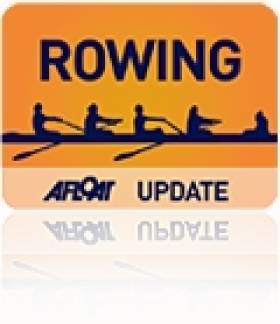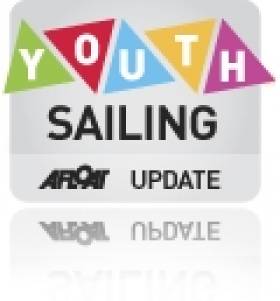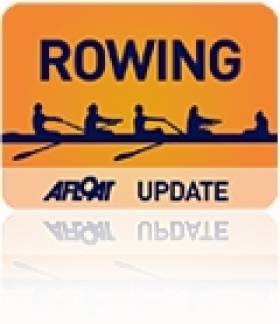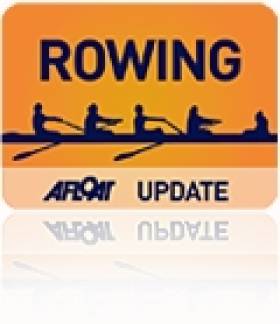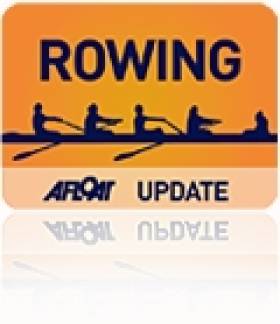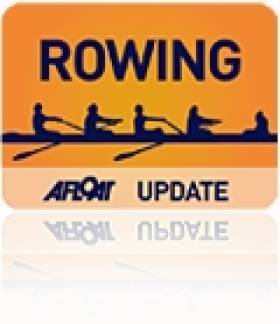Displaying items by tag: Trinity
Trinity Fall to Edinburgh at Henley Rowing Regatta
#ROWING: Edinburgh University beat Trinity College in the first round of the Temple Challenge Cup at Henley Royal Regatta today. The Scottish crew, managed to gain a lead and hold on to it. Trinity came back strongly at the finish but could not head their rivals. Brown University of the United States will be Edinburgh’s opponents tomorrow.
Henley Royal Regatta, Day One (Irish interest)
Temple Challenge Cup (Men’s Student Eight): Edinburgh University beat Trinity College, Dublin by a canvas, 6 mins 42 seconds.
Irish Rowing Crews Qualify For Henley Royal Regatta
#ROWING: The Lady Elizabeth coxed four and single sculler Anthony English both qualified for the main draw at Henley Royal Regatta today. The Lady Elizabeth crew of Brendan Smyth, Stuart King, Peter Waldron, David Meehan and cox Brendan Farrell will compete in the Britannia, while English, who has been based in Nottingham, is set for the the Diamond Sculls. It is the premier event for single scullers.
A number of Irish crews were not asked to pre-qualify. The Trinity senior eight will compete in the Temple Cup; Queen’s University have a quadruple scull in the Prince of Wales; Dave Neale and Eimantas Grigalius of Three Castles are entered in the Double Sculls.
Henley Royal Regatta – Qualifiers (Irish interest)
Diamond Sculls: A English
Britannia (Fours, coxed): Lady Elizabeth
#irishsailing – After five years of economic contraction, there are signs of recovery, and the 2014 Irish sailing season has also got off to a flying start. W M Nixon looks at various signs of new energy and initiatives, and sees how they might be affecting stories which have been run on this blog and in the Afloat.ie website during the past year. But he concedes that further cost reductions will be necessary for the good of the sport.
A year ago, any talk of green shoots in Ireland was almost entirely metaphorical. And it was in the economic sphere, though even there they were still few and far between, with many soon stunted. But out in the farmers' fields themselves, out where the grass should have been growing, there was scarcely a sign of life as we were still trapped in the coldest and most miserable Spring in living memory, and all forms of growth and recovery were blighted by it.
Sailing and boating, of all sports, are the most affected by Ireland's climatic conditions. Not only is the mood among participants strongly influenced by weather which sometimes can get anyone down, but without reasonable breezes, sailing events are seriously impaired. "We got a result!" may well be the PRO's final desperate claim after pulling some sort of a points table and leaderboard out of a series bedevilled either by too much or too little wind. But it's so much better to have a series bathed in sunshine and blessed by fine breezes, with enough races sailed for the crews to go home tired but happy without needing recourse to any of those weasel words which show you're only trying to justify a weekend of frustration.
Things could not be more different this year. The Spring of 2014 has been perfection, boats are going afloat on time and in reasonable weather conditions, and the first little crop of events and results are very encouraging indeed - so encouraging, in fact, that "little crop" doesn't do them justice.
That said, two of the nearer events which gave special cause for Irish celebration did not have perfect weather throughout. The Youth Sailing Nationals at Howth may have ended on a high with a great breeze in an early taste of summer sunshine, but one day out of the four was lost to bad weather. But the sting of that was lessened by the decision for "no racing all day" being taken at 1100hrs, which allows other leisure options to kick in.
The IRC Easter Championship in the Solent concluded through Easter Monday literally with "Darkness at Noon" – the heavy clouds and torrential rain on an almost windless day saw the final races being sailed with nav lights on. But there had been excellent racing on earlier days, and a very excellent result with Anthony O'Leary's Ker 39 Antix from Cork the clear supreme champion.
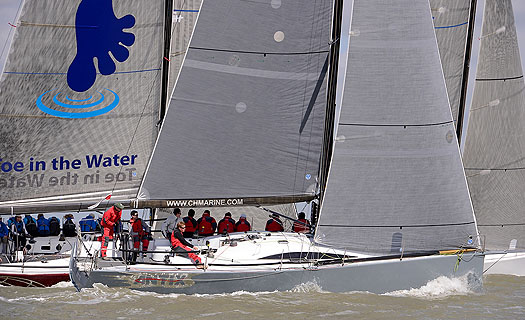
Doing the business. Anthony O'Leary's Ker 39 Antix settling into the groove on the way to the top place in the Easter IRC Championship. Photo: Rick Tomlinson
That in turn augured well for Ireland's Commodore's Cup chances, which then received a further boost last weekend when the crew of another Irish team wannabe, Quokka with Michael Boyd and Niall Dowling, had a winning weekend in the Warsash series with their temporary mount Tarka in anticipation of Quokka's return from the Caribbean at the end of May.

The Colours Match team racing between UCD and Trinity served up top sport in the Liffey, with Trinity winning. Photo: W M Nixon
Meanwhile the universities racing has been brought to life, for although UCD had a convincing win in the racing with the SailFleet J/80s to become the Irish team for the Student Yachting Worlds in France in the Autumn, before April was out the Colours Match in the Liffey under the burgee of the Royal Alfed YC, team-raced in Fireflies, saw Trinity take the honours in convincing style.
But if we're looking for something which really did set things freshly alight, it was out in Hyeres where the ISAF Championship saw the northern duo of Ryan Seaton & Matt McGovern take silver in the 49er, almost immediately moving them up the global rankings from 33 to 11, a quantum leap and no mistake.
The potential for serious success by these two has been fairly obvious for some time, but anyone who sails boats will know only too well how many factors have to come into alignment to get you up among the magic metals at the end of the day.

Stars of the silver sea – the Seaton/McGovern team took a silver medal for Ireland at Hyeres.
That their new global status was almost immediately acknowledged by this rankings improvement will in turn add heft to everything they do and say. Thus when, some time ago, the Ryan/Seaton equipe suggested that the 2016 Olympics sailing waters in Brazil are so off the standard as to be a health hazard, it attracted polite attention. But now that they're Number 11, and still counting down, much more notice is taken. And the fact that the Vice President of the International Olympic Committee has suggested, with something approaching despair, that the facilities in Brazil just aren't going to be ready for 2016 at any standard, all gives added legs to the statement from Ireland's 49er crew.
This in turn makes us wonder where world sailing might go in 2016 if the Brazilian setup is still Work in Progress. With tongue only slightly in cheek, we suggest they need look no further than West Cork, where Baltimore Sailing Club has been expanding its facilities to meet increased demand as a club which last year introduced something like 700 people to sailing. That BSC and current Mitsubishi Motors "Club of the Year" Kinsale YC further east along the West Cork coast have both been putting in premises up-grade during the past year, while other clubs have been having it tough, and just about hanging in there in some cases, surely gives pause for thought.
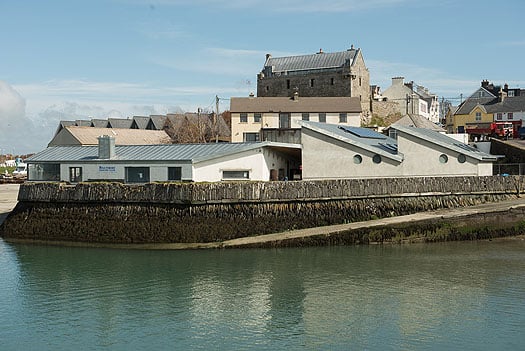
Olympic venue? The extended and up-graded Baltimore Sailing Club is ready and raring to go.
The economic shakeout of the past five years has caused a massive write-down in the value of almost all property and other assets. And in the case of yacht and sailing clubs, there has been a detailed examination of the continuing validity, or otherwise, of established yacht clubs and their traditional business model of quite high subscriptions under-writing other facilities which in turn combine to provide the complete package of an orthodox yacht club.
Inevitably, most clubs are run by officers and committee members who have been involved with the club for many years. Thus, like people who have been running a quality hotel for decades, they may have an inflated notion of what their organisation and its premises are actually worth. Admittedly there's only limited usefulness in comparing a yacht club with a hotel, but lessons can surely be learned. The fact is that hotels today are worth maybe only a third or even less of what they were reckoned to be worth six years ago. And equally, while yachts clubs certainly have a unique package to offer, is it unusual enough and special enough to charge high subscriptions when there are alternative facilities and services available?
The dilemma arises to some extent in all sailing centres. Last week we were discussing the story of the development of Howth YC. Today it is in the seemingly happy situation of having its own marina, thus it theoretically can offer an attractive all-in-one package to any potential member. But the very fact that Howth YC has done so much to help make Howth a colourful and vibrant sailing/fishing port is partly to its own disadvantage. The place has developed as a remarkable focus for top seafood restaurants. This means that the extensive club catering facilities – expected by traditional members - are constantly battling for business with a whole slew of award-winning eateries and characterful pubs nearby.
The problem is more acute in Dun Laoghaire in that the only club within the marina area is the Royal Irish YC. Thus while people may have been loyal members of the National, the Royal St George and the Dun Laoghaire Motor Yacht Club, they find that after going out in the boat, it's very easy to round out the evening aboard in the marina, chatting among themselves or with other crews on boats nearby, and then head straight for home without making their number in their home clubs at all.
This situation is less in evidence at weekends and during special events. But nevertheless it was causing such a lessening in mid-week club vitality that various steps have been taken, and the Royal St George's move to take over berths in a block booking in the outer marina, and service them by a frequent ferry direct from the clubhouse, is a visionary step.
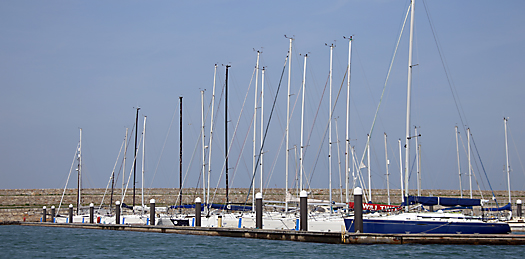
The Royal St George YC has introduced a direct ferry service from the clubhouse to its group of berths in the outer marina in Dun Laoghaire. Photo: David O'Brien
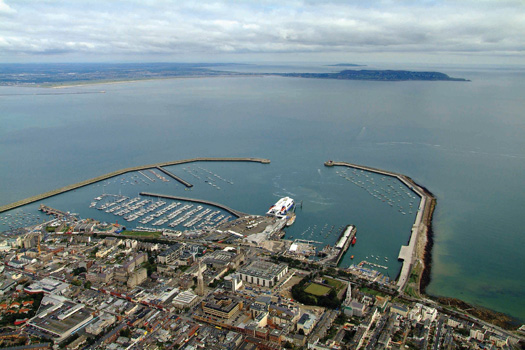
To overcome a lack of direct access to the Dun Laoghaire Marina, the Royal St George YC is running a ferry service from its clubhouse (to right of Stena Ferry, foreground) to the berths in the Outer Marina (upper left) Photo Kevin Dwyer/courtesy ICC.
Nevertheless, in all club administrations there are those who are of the opinion that, whatever the Honorary Treasurers may believe, there has to be a radical re-think of the primary subscription levels. In essence, they're suggesting that the book value of the club has to be written down such that subscriptions are halved. Personally, I haven't much of a notion of how to read a balance sheet, but the dogs in the street know that in the hospitality industry – which, in the broadest sense, is the area in which yacht and sailing clubs operate – values have been savagely slashed, and while charges may still seem high, at least the places are surviving as going concerns.
With continuing reduction in expenses across the board, one area in which there seems to be much work afoot is in the Irish Sailing Association, which in latter days had begun to seem like some hidden corner of the civil service, existing more for the benefit of staff than for the provision of services for sailors. It's amazing to learn that the ISA has sixteen fulltime staff, and a basic annual wages bill of something like €600,000. When you add in the expected benefits, it musty come in total to a very tidy yearly sum.
What on earth do they all do? While you'll invariably find the ISA logo in prominence at some top events, it has to be said that you're entirely unaware of the organisation's existence in any form at more everyday happenings, and it doesn't seem to be because they believe in doing good work by stealth. But with special study groups resulting from the major changes introduced in the ISA setup at the AGM in March, we can only hope that in time the Association will reflect the cost-cutting which has had to be introduced in the clubs, which provide the main part of the ISA's income.
While the administrative structures are rightfully being pared back in many areas of our sport, the coastal infrastructure, on which all forms of seagoing ultimately depend, continues to need maintenance and development. In this area, one very promising green shoot is the news that there are signs of movement in Dunmore East. A dredging programme is getting under way, and just this Tuesday, Minister for Marine Simon Coveney TD convened a meeting in the port to inaugurate a community approach to harbour development which, it is hoped, will help to invigorate the many places around Waterford Estuary, for which Dunmore East has the potential to be the true gateway harbour.

Dunmore East – can it fulfil its potential as the gateway leisure port for the Waterford Estuary? Photo Kevin Dwyer, courtesy ICC
In a more extreme marine environment, it has been confirmed that €6 million will be spent on improving the pier at Doolin in northwest Clare, the nearest mainland quay to the Aran Islands, which also caters for the tour boats cruising along the Cliffs of Moher. While the locals seem well pleased, I wouldn't get too excited about it. This is one very rugged part of the coast, and when you remember that it took €31 million to extend the pier at Kilronan in Inismor, the main Aran island, and another €14 million to build the little harbour at the north end of Inis Meain, the middle Aran island, then we can only hope that €6 million is going to achieve something more than a few boulders being shifted about in the roaring ocean at Doolin.

The pier at Doolin is decidedly minimalist, but it provides the shortest sea passage to the Aran Islands. Photo: W M Nixon
But then, in the west all things are possible, and along the ocean seaboard we're told that four thousand signs are being erected to guide people along the Wild Atlantic Way, the new tourism initiative using many smaller coastal roads. Quite so. Frankly, with signage at this level, it will be the Tame Atlantic Way by the time half of them are in place. I have to admit to being a complete curmudgeon in this. In many years of transitting Ireland's west coast by sea and land, one of our favourite areas while driving along the west coast has long been the coast south of Kilkee down to Loop Head, where the cliffs comfortably rival anything the vulgar Cliffs of Moher have to offer, and it is magnificently uncrowded. But not any more, if the Wild Atlantic Way movement has its way.
While I appreciate that visitor numbers have to be kept up and increased whenever and however, it has to be done in a way which appreciates that's what brings people to Ireland (rather than just to Dublin, which is a special case) is an unspoilt landscape. So, four thousand signs just for the one Atlantic Way? Ogden Nash had something to say about this:
"I think that I shall never see,
A billboard lovely as a tree.
But then, until the billboards fall,
I'll never see a tree at all".
Be that as it may, the final sign that suggests things are on the move again is a notice I spotted recently posted at a nearby club, though language pedants might wonder how a notice which manages to mangle so utterly the plural of "dinghy", even to adding a completely superfluous greengrocer's apostrophe, could be seen as encouraging in any way whatsoever.
Well, once you've overcome your opinions about the errors, the underlying message must be good news. More youngsters are evidently coming to sailing this year. And as for the spelling mistake, even that's an improvement. A year ago, the same notice board opened by referring to something called "a dingy", but this time round we have to get to the second line before finding that. And it all comes right for dinghies in the end.
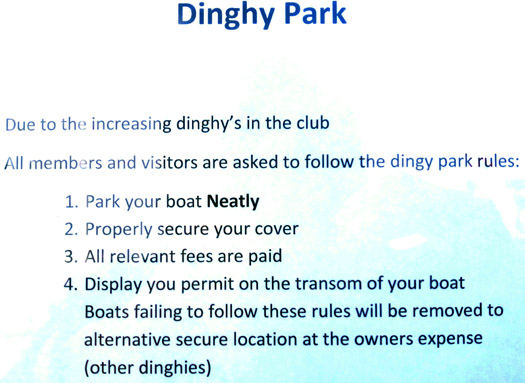
Sign of the times? Whatever about the spelling, this current notice at an Irish sailing club has an underlying message of good news. Photo: W M Nixon
Trinity Senior Eight are Afloat Rowers of the Month for April
#ROWING: The Trinity men’s senior eight are the Afloat Rowers of the Month for April. The crew won at the Irish Universities’ Championships at the National Rowing Centre in Cork, beating UCD, and they were convincing victors over NUIG/Gráinne Mhaol at the first Grand League regatta of the year, Skibbereen Regatta. Gráinne Mhaol/NUIG, in some combination, have won four of the last five national titles.
In March, Trinity had been beaten by UCD in a stirring battle in the Gannon Cup and they had also been joint winners of the Dublin Head of the River, dead-heating with a composite crew of Commercial, Gráinne Mhaol and Old Collegians.
Rower of the Month Awards: The judging panel is made up of Liam Gorman, rowing correspondent of The Irish Times and David O'Brien, Editor of Afloat magazine. Monthly awards for achievements during the year will appear on afloat.ie and the overall national award will be presented to the person or crew who, in the judges' opinion, achieved the most notable results in, or made the most significant contribution to rowing during 2014. Keep a monthly eye on progress and watch our 2014 champions’ list grow.
Trinity Win Colours Team Race in River Liffey Test
#coloursmatch – The annual Colours races between UCD and Trinity underwent a revitalisation this year, with a new location, new format and all new commentary. It was run over the whole day on Saturday (12th April). The event was held in the heart of Dublin city, in front of the Convention Centre on the Liffey. Spectators watched from the quays and the MV Cill Airne, while listening to Chris Tordoff, Ireland's most talked about sailing commentator.
The Colours match was organised from a sailing point of view by the Royal Alfred Yacht Club, using material provided by the Royal St George. Poolbeg generously allowed their premoses and pontoons to be used.
A full schedule of races was completed, with all the teams bar the firsts and alumni taking part in 2 round robins, of which UCD 2 and UCD 4 won the Gold and Silver round robins respectively. The alumni races were held shortly after, and Trinity came out on top in their best of 3 race, where some of the past leaders of each club fought it out, trying to remember their skills from their college days.
The ladies race which was scheduled unfortunately did not get to be completed due to the time restrictions on lifting the East Link bridge to get the boats back out to Poolbeg Yacht and Boat Club. However, while UCD came out on top in both round robins, the title of Colours Champions goes to whichever college wins the best of 5 races between the colleges. UCD were favourites after their win at Varsities in February, however Trinity had been training hard to break UCD's winning streak over the past 4 years. With the flow in the river picking up pace, the highly contested races began with a large crowd gathered on the MV Cill Airne to watch.
Trinity had great starts, and took an early lead in the first 2 races to hold on and win both. With UCD's hopes coming down to the do or die 3rd big performance was needed. The 3rd between the sides a few times, until Trinity pulled out a very solid final beat to go on to win their first Colours match in 4 years. The winning Trinity team was Scott Flanigan, Lucy Bolger, Jack Hogan, Iain Irvine, Rich Roberts and Ally Dix.
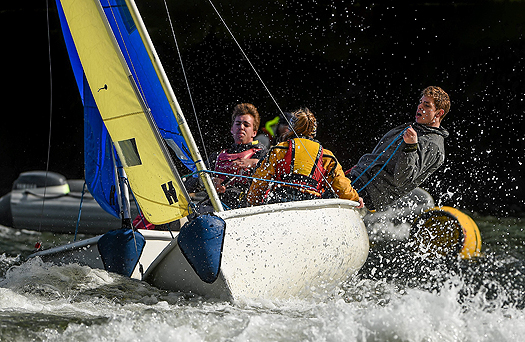
Cillian Dickson, right, and Albha McDermott, Trinity College, in action against Cian Mollen, University College Dublin, left, during their race. Photo: Pat Murphy/Sportsfile
The Colours match marks the end of the college sailing circuit for 2013/14. While there was not much sailing achieved at the 3 events before Varsities, it was still a remarkable year. UCD won one of the tightest Varsities finals in years, the Student Yachting Nationals in Howth were incredibly close between the 8 J80s, and Colours was run with unparalleled success. Colours on the Liffey should become a yearly event after its success this year.
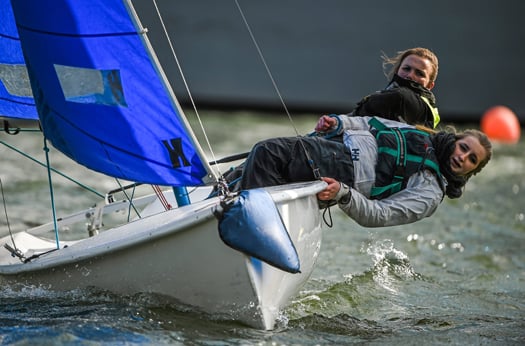
Sophie Murphy and Ali Moorhead, University College Dublin. Photo: Pat Murphy/Sportsfile
Thanks must be given to Energia and Bank of Ireland for their support in running the event, without which the event definitely would not have taken place, and to the MV Cill Airne for hosting the sailors during the day and night.
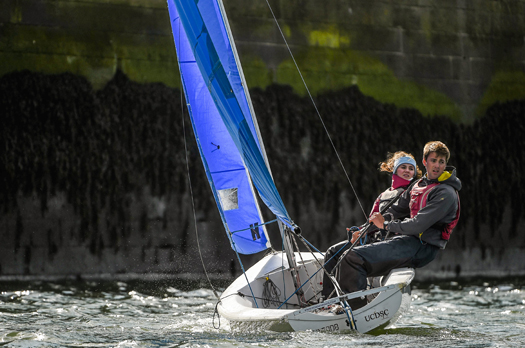
Cian Mollen and Emily Jones of University College Dublin. Photo: Pat Murphy/Sportsfile
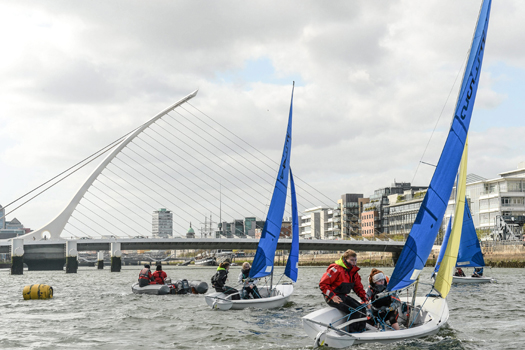
In the shadow of the Samuel Beckett bridge. A general river Liffey view of the racing action during the final race between University College Dublin and Trinity College. Photo: Pat Murphy/Sportsfile
The Winner's View...
Trinity College Sailing reports on how its 2014 sailing season finished with a bang, beating the UCD favourites to win the Colours for th first time in five years
For the first time ever, the annual colours match between arch rivals Trinity College Dublin and their noisy neighbours UCD took place on the River Liffey. UCD commodore Vinnie Varley pulled out all the stops and had the bridge lifted for all 12 boats to sail to the race area which was beside the MV Cill Airne. There was serious tension between the two colleges in the lead up to the event, with UCD snatching a win from TCD on countback in the Student Yachting Nationals the week before along with the usual undertones from the Belfield campus.
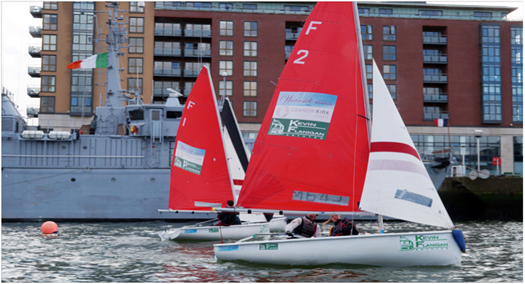
TCD Alumni, helms Jake Mealy, Luke Finnegan and Christopher O'Reilly won their best of three series, starting off Trinity's victory. Photo– Stephen Doyle/Vision Media
All sailors were faced with very challenging racing conditions aside from the shifty and gusty breeze. With one eager fresher commenting "There were obstacles such as the Liffey Barge that we were not normally used to having to deal with!". Spectators watched from the MV Cill Airne where running commentary was provided by The Viper, who's focus was more on tales of ferry journeys than on the fireflies!
The morning provided a different running order to usual, with the 2nd-5th's racing in a round robin. The Trinity faithful were spurred on following the return of the familiar face of Finn Murphy , who spurred the "Fighting fifths" on up the last beat to secure one of the most dramatic wins of the day. TCD 2 went unbeaten in the morning round robin with the young guns of TCD 4 also putting in a big performance to pave the way for an upset.
After a mid day interval for lunch, the TCD alumni went out to set down a marker for the afternoon. Winning their side of the event 2-1 added to the shift in momentum towards the much debated rebranded "Trinity College, The University of Dublin. "
The colours match, decided on the result of the race between the two first teams, has a funny history of long winning streaks. Until 2010, Trinity had won four years in a row from 2006 and since then UCD were on a roll themselves during a golden period. Trinity were fired up to prevent UCD achieving the elusive five in a row and started strongly with a 1,2 off the line in the first race of the best of five series. This was followed up by another commanding 1,2 win setting up a tantalising prospect for the Trinity fans of a whitewash against the favourites and current Intervarsity champions.
TCD Alumni, helms Jake Mealy, Luke Finnegan and Christopher O'Reilly won their best of three series, starting off Trinity's victory.
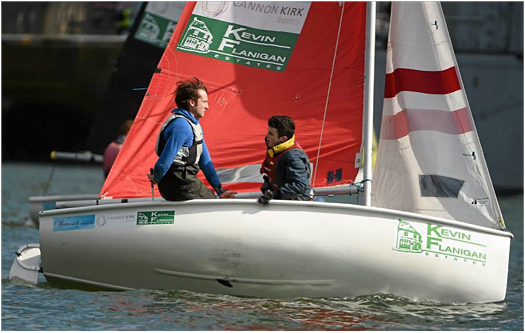
Jack Hogan and Iain Irvine (TCD 1) on the way to a comprehensive win. Photo: Pat Murphy/Sportsfile
The final race had all the supporters raised from the comfort of their seats on the Cill Airne as the drama continued right until the last beat, where Trinity converted back from a 1,4,6 into a 1,2,3 to take the Colours match by 3-0 in the best of five series. It was fantastic to hear chants of TCD across the Liffey within a few hundred metres of the iconic Front Square.
Unfortunately due to time constraints, the ladies race had to be abandoned however there were several unconfirmed sources claiming that fear had struck given the talk of Ally Dix's proposed return to the helm.
The win marks a sign of great progress for The University of Dublin as they look to rebuild towards another golden period of their own. A renewned sense of pride in our teams performances was notable.
The clubs main focus for the 2013/2014 season was on an increased racing schedule which involved three Uk trips. These were only possible due to the kind sponsorship from the TCD Alumni fund, who helped finance members from our top three teams competing in Cambridge. We would also like to thank our other main sponsors from Waterside Malahide, Cannon Kirk and Kevin Flanigan Estates who contributed greatly throughout the year towards subsiding our competition costs.
If you would be interested in sponsorsing our club or the colours event for the 2014/2015 please email [email protected] . As can be seen from the images substantial advertising space is available.
A huge thank you must go to UCD for organising such a fantastic event and also to all those who came to support from both Universities. No doubt this event will continue to go from strength to strength in it's new location.
TCD 1: Scott Flanigan/Lucy Bolger, Jack Hogan/Iain Irvine, Richard d'Esterre Roberts/Ally Dix
TCD 2: Harry O'Reilly/Kerrie O'Leary, Cillian Dickson/Alva McDermott, Jennifer Andreasson/Charlotte Murphy
TCD 3: Amy Swinglehurst/Emma Flood, Patrick Collins/Amelia O'Keefe, Annabel Elliot/Max Hickey
TCD 4: Dermott O'Flynn/Larragh Lee, Brian Carthy/Anna Hayes, Paul Martin, Florence Fanning
TCD 5: Finn Murphy/Louise O'Callaghan, James Eggers/Alison Greene, Michael Craig/Christabel Cavey
TCD Alumni: Jake Mealy/Rachael Flood, Chris O'Reilly/Alice Wyse Jackson, Luke Finnegan/Colm McLovin
Trinity Rowers Beat NUIG/Gráinne Mhaol at Skibbereen Regatta
#ROWING: Trinity beat NUIG/Gráinne Mhaol into second to win the Division One men’s eights final in warm sunshine at the Skibbereen Regatta at the NRC in Cork today. This was a surprisingly emphatic win, with over five seconds in it at the finish.
The Division One women’s final was much closer. UCD’s eight held off repeated pushes by Trinity to win by .6 of a second.
Gráinne Mhaol had earlier won the Division One men’s fours final, while a composite with international hopes – Marie O’Neill, Aifric Keogh, Emily Tormey and Barbara O’Brien were by far the best women’s four.
The Skibbereen men’s double of Gary O’Donovan and Shane O’Driscoll had a fine win in the Division One final.
Skibbereen Regatta, National Rowing Centre, Cork (Sunday Results)
Men
Eight – Division One – A Final: 1 Trinity (A McElroy, D Butler, J Magan, P Moreau, M Corcoran, M Kelly, L Hawkes, I Hurley; cox: C Sheehan; senior) 5:55.1, 2 NUIG/Gráinne Mhaol (sen) 6:00.5, 3 Carlow (inter) 6:12.7; 4 Portora (jun 18) 6:14.6. B Final: Trinity (inter) 6:09.5.
Four – Division One – A Final: 1 Gráinne Mhaol 6:20.1, 2 Commercial 6:23.9, 3 NUIG 6:30.9.
Four, coxed – Division Two – A Final: 1 UCD (club two) 7:00.3, 2 Trinity (club two) 7:03.3, 3 Trinity B (club two) 7:05.7; 4 St Michael’s (jun 18) 7:06.4. B Final: Blackrock (club two) 7:04.6; 2 Portora (jun 16) 7:08.3. C Final: Pres, Cork 7:23.7.
Sculling, Quadruple – Division Two – A Final: 1 Commercial (jun 16) 6:45.9, 2 Clonmel (jun 18) 6:52.1, 3 Lee (club two) 6:53.5. B Final: Skibbereen (jun 18) 6:59.6. C Final: Athlunkard (jun 16) 7:21.6.
Double – A Final: 1 Skibbereen (u-23) 6:38.6, 2 UCC (sen) 6:41.6, 3 Shannon (jun 18) 6:55. B Final: Shannon (sen) 6:55.4; 2 Garda (inter) 6:59.2. C Final: Garda (club one) 7:16.7.
Single – Division Two – A Final: 1 Clonmel (S Channon; jun 18) 7:41.4, 2 Belfast BC (A Murray; club two) 7:46.7, 3 Lee (D Synott; jun 18) 7:49.7; 4 Shandon (S O’Sullivan; jun 16) 7:51.1. B Final: Clonmel (S Lonergan; jun 18) 7:46.9. C Final: Carrick-on-Shannon (T McCabe; jun 16) 7:55.6.
Women
Eight – Division One – A Final: 1 UCD (C Harrison, A Crowley, S Bennett, R Larsen, O Finnegan, G Collins, A Gilligan, R Gilligan; Cox: A O’Leary; inter) 6:41.2, 2 Trinity (sen) 6:41.8, 3 Cork (sen) 6:56.0; 5 Portora (jun 18) 7:09.4. B Final: Trinity (u-23) 7:13.1.
Four – Division One – A Final: Univ of Limerick, Cork, Gráinne Mhaol, NUIG (sen) 6:59, 2 UCD (u-23) 7:16.6, 3 Skibbereen (sen) 7:24.9; 4 Skibbereen (jun) 7:28.5. B Final: Muckross (jun 18) 7:35.6.
Four, coxed – Division Two – A Final: 1 Commercial (club two) 7:50.7, 2 Garda (club two) 8:07.7, 3 Trinity A (club two) 8:37.1; 4 Muckross (jun 16) 8:37.4.
Sculling
Double – Division One: 1 Skibbereen (sen) 7:33.4, 2 UCC A (inter) 7:42.5, 3 Commercial (jun 18) 7:44.7; 5 Belfast BC (club one) 8:07.4. B Final: Killorglin (inter) 8:03.4.
Single – Division Two – A Final: 1 Belfast BC (K Turner; club two) 8:25, 2 UCC (D O’Sullivan; club two) 8:29.8, 3 Belfast BC (S Quinn; club two) 8:31.1; 4 Lee (E Cummins; jun 16) 8:39.0, 5 Muckross (Z Hyde; jun 18) 8:42.9. B Final: Lee (C Synott; jun 16) 8:38.9. C Final: Lee (S O’Mahoney; jun 16) 8:57.2.
Trinity Win Senior Eights But UCD Take Wylie and BoI Trophies
#ROWING: UCD took the Wylie Cup for men and the Bank of Ireland Cup for women at the University Championships of Ireland at the National Rowing Centre in Cork today. Under the new rules two wins in eights across the grades of Novice, Intermediate, Club and Senior grades sufficed. UCD won the men’s Novice and Club eights and the Novice and Intermediate in women’s eights.
It was, however, a particularly good day for Trinity. They bested UCD in both the senior men’s and women’s eights and won the overall points classification.
University Championships of Ireland, National Rowing Centre (Selected Results)
Men
Wylie Cup: UCD
Eight – Senior: 1 Trinity, 2 NUIG, 3 UCD. Club: 1 UCD A, 2 Trinity, 3 Queen's. Intermediate: 1 NUIG, 2 Trinity, 3 UCD A. Novice: 1 UCD A, 2 Trinity A, 3 Queen’s A.
Four – Club, coxed: UCD A.
Pair – Senior: UCC.
Sculling, Quadruple – Senior: UCC. Novice: Queen’s. Double – Intermediate: Cork IT. Single – Senior: 1 Univ of Limerick (M O’Donovan). - Intermediate: UCC (S O’Connor).
Women
Bank of Ireland Cup: UCD
Eight – Senior: 1 Trinity B, 2 UCD, 3 Trinity A. Club: 1 NUIG, 2 Queen's, 3 Trinity. Intermediate: 1 UCD, 2 NUIG, 3 Trinity. Novice: 1 UCD, 2 Queen’s A, 3 Trinity B.
Four – Senior: Trinity B. Club, coxed: NUIG. Intermediate, coxed: UCC.
Sculling, Quadruple – Novice, coxed: NUIG. Double – Intermediate: Trinity B.
Single – Intermediate: Trinity (S Dolan).
Overall Points Winners: Trinity.
Rowers From Commercial and Old Collegians Shine at Neptune
#ROWING: A Commercial/Old Collegians composite eight beat Trinity to win the men’s senior eights title at the Neptune Regatta at Islandbridge today. The winners had just half a length to spare at the end of a good race.
Michael Maher, the number two man in the winning boat, had earlier won the senior single sculls, while Holly Nixon beat Eimear Lambe in the women’s club one single sculls.
The event was held in excellent, sunny, conditions.
Neptune Regatta, Islandbridge
Men
Eight – Senior: Commercial/Old Collegians (N Gahan, M Maher, R Peguet, S Jacob, D Neale, A Maher, F Groome, J Graham; cox G Connolly) bt Trinity, ½l. Novice: UCD B bt Trinity B, 3l. Masters: Belfast RC bt Carlow 1½ l. Junior 16: Portora bt Bann 4l.
Four – Club One, coxed: UCD bt Blackrock, ¾l. Intermediate, coxed: Trinity bt Neptune, easily. Junior, coxed: Portora bt Bann 6l. Masters, coxed: Carlow (D) bt Commercial (C) easily
Sculling, Quadruple – Club Two, coxed: Commercial bt Athlone 2½ l. Junior 18: Athlone bt Commercial 1½ l.
Junior 16, coxed: Commercial bt Bann, 4l. Junior 15, coxed: St Michael’s bt Methodist Col, 1½ l. Junior 14, coxed: New Ross bt St Michael’s ½ l.
Double – Junior 16: St Michael’s bt Graiguenamanagh, easily
Single – Senior: Commercial (M Maher) bt Trinity (G Como) easily. Club One: Garda (D Kelly) bt UCD (Toland) canvas. Club Two: Trinity (Addison) bt Trinity (Slevin). Intermediate One: Trinity (Rooney) bt Sligo 2l. Junior 18: Clonmel (Shannon) bt Clonmel (Lonergan). Junior 16: Graiguenamanagh (Lennon) bt Graiguenamanagh (Scully) 3l.
Women
Eight – Club One: Portora bt UCD, 3½ l. Junior 18: Portora bt Bann. Junior 16: Portora bt Galway, 2l. Junior 15: Portora A bt Portora B 2l.
Four – Club One, coxed: Commercial A bt Commercial B, easily.
Sculling, Quadruple – Club Two: Galway bt Neptune, 2½ l. Junior 18: Neptune bt Methodist Col, 4l. Junior 16, coxed: Bann bt St Michael’s 4l. Junior 15, coxed: Commercial bt Methodist Col 4l. Junior 14, coxed: New Ross bt St Michael’s.
Double – Junior 16: Clonmel bt Methodist Col Did Not Finish. Junior 15: Col Chiarain bt Clonmel 4l.
Single – Club One: Portora (H Nixon) bt Commercial (E Lambe) 1l. Club Two: Carlow (H O’Toole) bt Athy 2l. Jun 18: Commercial (A Rodger) bt Methodist Col. Junior 16: Clonmel bt Sligo (Did Not Finish).
Dublin Head A Dead Heat - Again
#ROWING: The Dublin Head of the River today ended in a dead heat – for the second successive year. The senior eight from Trinity and the composite crew of Commercial and Old Collegians were both timed at 11 minutes 39 seconds for the run from the Ha’penny Bridge to Islandbridge. A number of boats ran into difficulty at the bridge at Heuston Station. Last year was the first time the event had a dead heat – UCD divided the honours with a composite crew. Dublin Head of the River, Ha’penny Bridge to Islandbridge (Selected Results) Overall: 1 Trinity senior eight and Commercial/Old Collegians senior eight 11 minutes 39 seconds, 3 UCD senior eight (time only) 12:08, 4 Carlow/Three Castles senior eight 12:10, 5 Trinity intermediate eight 12:28, 6 Neptune senior eight 12:37. Men, Eight – Senior: 1 Trinity and Commercial/Gráinne Mhaol/Old Collegians 11:39, 3 Carlow/Three Castles 12:10. Intermediate: Neptune 12:28. Novice: Queen’s 13:35. Junior: Blackrock College 15:07. Masters: Commercial 13:25. Fours – Senior: Commercial (quadruple, coxed) 15:00. Intermediate: Garda 15:04. Women, Eight – Senior: UCD 14:31. Intermediate: UCD 15:55. Novice: Garda 17:11. Junior: Commercial 16:44. Fours – Senior: Trinity (time only) 18:55, 2 Neptune 21:50.
| PLACE | CREW NO | CREW NAME | Category | TIME TAKEN | MARGIN | |||
|---|---|---|---|---|---|---|---|---|
| MIN | SEC | MIN | SEC | |||||
| 1 | 1 | Dublin University Boat Club | M Senior 8 | 11 | 39,00 | 0 | 0.00 | |
| 2 | 2 | Commercial RC - Commercial RC/Grainne Mhaol/C | M Senior 8 | 11 | 39.00 | 0 | o~oo | |
| 3 | 5 | UCD BO (time only) | M Senior 8 | 12 | 8.00 | 0 | 29.00 | |
| 4 | 4 | Cadow Rowing Club - Carlow Rowing Club/Three C | M Senior 8 | 12 | 10.00 | 0 | 31.00 | |
| 5 | 6 | Dublin University Boat Club | M Inter 8 | 12 | 28.00 | 0 | 49.00 | |
| 6 | 3 | Neptune Rowing Club | M Senior 8 | 12 | 37.00 | 0 | 58.05 | |
| 7 | 8 | Commercial RC (c 387) | M Masters 8 | 13 | 25.00 | 1 | 46.00 | |
| 8 | 7 | Carlow Rowing Club | M Inter 8 | 13 | 26.00 | 1 | 47.00 | |
| 9 | 18 | Queens University Belfast Boat Club | M Novice 8 | 13 | 35.00 | 1 | 56.00 | |
| 10 | 21 | UCD BC (time only) | M Novice 8 | 13 | 49.00 | 2 | 10.00 | |
| 11 | 9 | Neptune Rowing Club - Commercial RC/Neptune RM | Masters 8 | 13 | 57.00 | 2 | 18.00 | |
| 12 | 16 | Dublin University Boat Club | M Novice 8 | 14 | 8.00 | 2 | 2900 | |
| 13 | 13 | UCD BC | W Senior 8 | 14 | 31,00 | 2 | 52.00 | |
| 14 | 19 | Dublin University Boat Club B | M Novice 8 | 14 | 46.00 | 3 | 7.00 | |
| 15 | 22 | Commercial RC 4X+ | M Senior 4 | 15 | 0.00 | 3 | 21.00 | |
| 16 | 36 | Garda Boat Club | M Inter 4 | 15 | 4.00 | 3 | 25.00 | |
| 17 | 10 | Old Collegians Boat Club (f 486) | M Masters 8 | 15 | 6.00 | 3 | 27.00 | |
| 18 | 25 | Blackrock College Rowing Club Jun 16 | M Junior 8 | 15 | 7~00 | 3 | 28.00 | |
| 19 | 14 | Dublin University Ladies Boat Club B | W Senior 8 | 15 | 29.00 | 3 | 50,00 | |
| 20 | 27 | UCD BC | W Inter 8 | 15 | 55.00 | 4 | 16.00 | |
| 21 | 38 | Commercial RC | M Inter 4 | 16 | 6.00 | 4 | 27.00 | |
| 22 | 17 | Neptune Rowing Club | M Novice 8 | 16 | 14.00 | 4 | 35.00 | |
| 23 | 39 | Blackrock College Rowing Club | M Inter 4 | 16 | 16.00 | 4 | 3700 | |
| 24 | 20 | Queens University Belfast Boat Club B | M Novice 8 | 16 | 28.00 | 4 | 49.00 | |
| 25 | 24 | Neptune Rowing Club Jun 16 | M Junior 8 | 16 | 35,00 | 4 | 56.00 | |
| 26 | 11 | Three Castles Rowing Club - City of Derry Boating | M Masters 8 | 16 | 41.00 | 5 | 2.00 | |
| 27 | 40 | Commercial RC | W Junior 8 | 16 | 44,00 | 5 | 5.00 | |
| 28 | 31 | Garda Boat Club | W Novice 8 | 17 | 11.00 | 5 | 32.00 | |
| 29 | 37 | Dublin University Boat Club B | M Inter 4 | 17 | 21.00 | 5 | 42.00 | |
| 30 | 28 | UCD BC | W Novice 8 | 17 | 24.00 | 5 | 45.00 | |
| 31 | 29 | Dublin University Laaies Boat Club | W Novice 8 | 17 | 38.6-0- | 5 | 59.00 | |
| 32 | 41 | Neptune Rowing Club | W Junior 8 | 17 | 40.00 | 6 | 1.00 | |
| 33 | 15 | Commercial RC | M Novice 8 | 17 | 53.00 | 6 | 14.00 | |
| 34 | 32 | Dublin University Ladies Boat Club B | W Novice 8 | 17 | 58.00 | 6 | 19.00 | |
| 35 | 12 | Dublin University Ladies Boat Club (time only) | W Senior 4 | 18 | 55.00 | 7 | 16.00 | |
| 36 | 35 | Dublin University Boat Club | M Inter 4 | 19 | 47.00 | 8 | 8.00 | |
| 37 | 34 | Neptune Rowing Club | W Senior 4 | 21 | 50.00 | 10 | 11.00 | |
| 38 | 30 | Queens University Belfast Ladies Boat Club | W Novice 8 | 874 | 32.00 | 862 | 53.00 | |
| 39 | 23 | Dublin University Boat Club 4X+ | M Senior 4 | 999 | 0.00 | 987 | 21.00 | |
| 40 | 26 | Commercial RC Jun 16 | M Junior 8 | 999 | 0.00 | 987 | 21.00 | |
| 41 | 33 | Queens University Belfast Ladies Boat Club B | W Novice 8 | 999 | 0.00 | 987 | 21,00 | |
| 42 | 42 | Commercial RC | W Inter 4 | 999 | 0.00 | 987 | 21.00 | |
UCD Rowers Win Terrific Gannon Cup Race
#ROWING: UCD won the Gannon Cup for senior men after a terrific struggle, while Trinity senior women took the Corcoran Cup in facile fashion at the Colours Rowing Races on the Liffey today.
Trinity’s crew led the Gannon Cup race from just after the start, but could not gain a clearwater lead. UCD’s pushes were relentless, and though they were still behind coming through the final bridge, Watling Street, they then powered through and had command of the race when Trinity’s number four man and captain, Luke Acheson, collapsed. The race was not rowed out. It took a long time – too long - to get Acheson into an ambulance, as he had to be brought up the river all the way to City Quay before being lifted up the steps. He was being treated in St James’s Hospital this afternoon.
Trinity’s Corcoran Cup crew demonstrated that size is not everything in rowing. They were outsiders, but simply rowed better than UCD. They eked out an early lead and built it steadily into an unassailable margin by the end.
UCD’s annexation of the Sally Moorhead Trophy for novice women was also one-sided, but Trinity took the novice men’s title after UCD suffered a boat-stopping crab right in front of the Four Courts. UCD came back to lead briefly, but Trinity took control again before the finish.
Colours Rowing Races, O’Connell Bridge to St James’s Gate
Men – Senior (Gannon Cup): UCD (M Bailey, W Yeomans, C O’Riada, B Crosse, D O’Neill, A Griffin, P Moore, N Kenny (stroke); cox: L Mulvihill) bt Trinity not rowed out. Novice (Dan Quinn Shield): Trinity bt UCD 1 ½ l.
Women – Senior (Corcoran Cup): Trinity (G Crowe, H O’Neill, H McCarthy, R Deasy, S O’Brien, A Leahy, S Cass, R Morris (stroke); cox: N Williams) bt UCD easily.
Novice (Sally Moorhead Trophy): UCD bt Trinity easily.





























